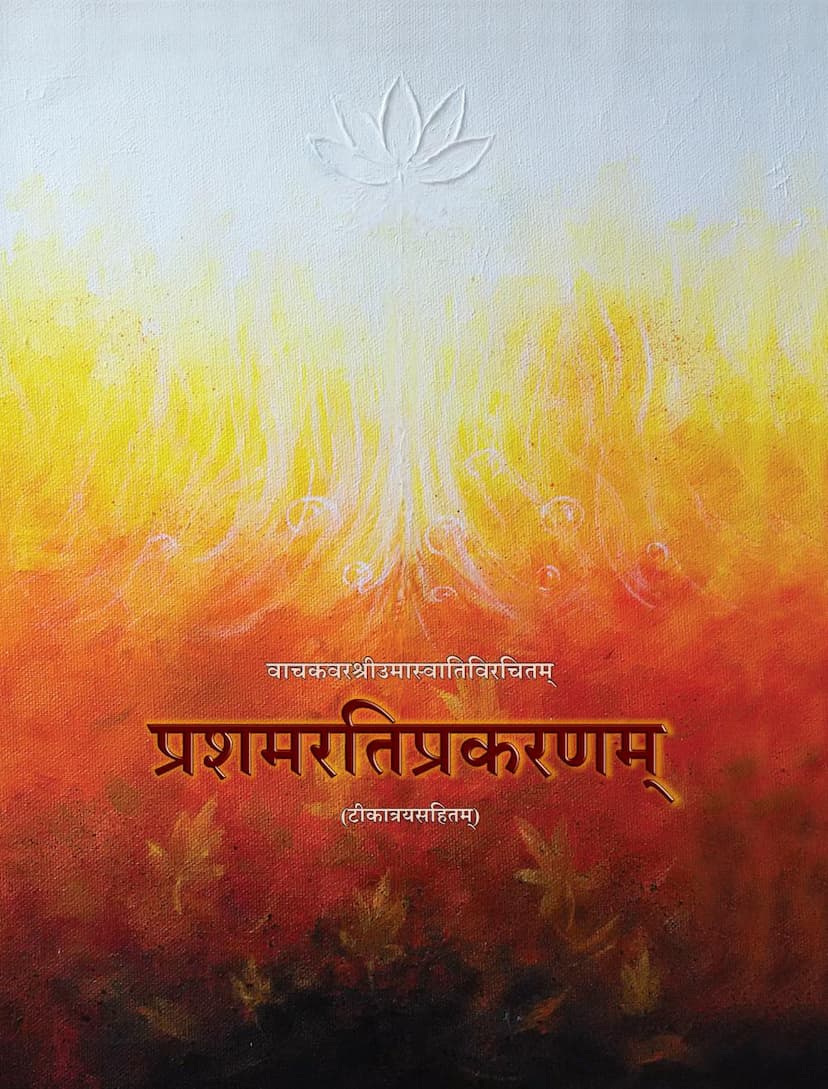Prasharamrati Prakaranam
Added to library: September 2, 2025

Summary
The Jain text "Prasharamrati Prakaranam" (प्रशमरतिप्रकरणम्) is a significant philosophical work attributed to Acharya Umāsvāti (also known as Umaswami), who is also renowned for the Tattvārtha Sūtra. The book's title, "Prasharamrati Prakaranam," translates to "Discourse on Tranquility" or "Essence of Calmness," indicating its central theme of achieving inner peace and detachment.
Here's a comprehensive summary based on the provided pages:
Core Theme and Purpose:
The central aim of "Prasharamrati Prakaranam" is to guide individuals towards achieving profound inner peace (Prashama) and equanimity (Rati) by cultivating detachment (Vairagya) from worldly desires and attachments. It emphasizes the Jain principles of non-violence, non-attachment, and spiritual discipline as the path to liberation from the cycle of birth and death (Samsara).
Author and Context:
- Author: Acharya Umāsvāti Vācaka (वाचकवरश्रीउमास्वाति), a highly respected scholar and ascetic, believed to have lived around the 5th-6th century CE. He is credited with composing 500 Prakaranas (chapters or discourses).
- Commentaries: The text is presented with multiple commentaries, including an ancient, unidentified commentary (प्राचीनटीका), a detailed explanation (विवरण) by Acharya Haribhadrasuri (आ. श्री हरिभद्रसू.म.), and an Avachurni (अवचूर्णिसहितम्). This indicates the text's importance and the need for elaboration to understand its profound teachings.
- Historical Context: The publication details highlight the efforts of institutions like Shrutbhuvan Sansodhan Kendra, Jain Dharmaprasarak Sabha, and Devchand Lalbhai Pustakoddhar Fund in preserving and disseminating Jain scriptures. The mention of seeking authenticity through ancient manuscripts underscores the commitment to accurate textual transmission.
Key Philosophical Concepts and Structure:
The text is structured into 22 primary chapters (Adhikaras), covering a wide spectrum of Jain philosophy and practice:
- The Nature of Existence and Liberation: It begins by invoking the victorious Jinānas (Jinas), the emancipated souls, emphasizing their transcendence over worldly existence and their attainment of ultimate peace. The text highlights the difficulty of human birth and the fleeting nature of life, urging introspection and spiritual effort.
- The Path of Detachment (Vairagya): A significant portion is dedicated to explaining the path of detachment through understanding the impermanence of worldly phenomena, the suffering inherent in Samsara, and the illusory nature of sensory pleasures.
- The Role of the Senses and Passions (Kashayas): The text details how sensory pleasures and passions like anger, pride, deceit, and greed lead to suffering and bondage. It emphasizes controlling the senses and overcoming these passions through mindful practice.
- Karma and its Effects: The work delves into the concept of karma, its eightfold classification, and how actions driven by passions lead to the accumulation of karmic matter, binding the soul to the cycle of rebirth.
- Virtuous Conduct and Practices: It outlines the importance of right faith (Samyaktva), right knowledge (Samyak Jnana), and right conduct (Samyak Charitra) as the three jewels of Jainism. Various practices like meditation (Dhyana), austerities (Tapas), and self-discipline are prescribed.
- The Teachings of the Jinās: The text repeatedly refers to the teachings of the Jinās (Tirthankaras) as the ultimate source of truth and the guide for achieving liberation.
- The Importance of the Teacher (Guru): It stresses the significance of having a spiritual guide (Guru) for proper understanding and practice of the teachings.
- The Concept of "Prashama": The core concept of "Prashama" (tranquility) is explained as the state of equanimity achieved through the suppression of passions and the cultivation of inner peace. This state is considered the highest goal, leading to ultimate liberation.
- Ethical Conduct: The text details ethical guidelines for monks and lay followers, including principles of non-violence, truthfulness, non-stealing, celibacy, and non-possession.
- The Nature of the Soul and Reality: It discusses the soul (Jiva) and its inherent purity, clouded by karma, and the nature of non-soul entities (Ajiva).
- Stages of Spiritual Progress: The text implicitly describes the spiritual journey, moving from overcoming passions and sensory attachments to achieving the state of liberation (Moksha).
- The Goal of Liberation (Moksha): The ultimate aim is Moksha, the state of eternal peace, bliss, and omniscience, free from the cycle of birth and death.
Commentaries and Their Role:
The presence of multiple commentaries highlights the complex and profound nature of the teachings. The commentators explain the core text, clarify difficult passages, and provide context, making the philosophical insights accessible to a wider audience. The specific mention of Acharya Haribhadrasuri's commentary indicates his significant contribution to the text's elucidation.
Overall Message:
"Prasharamrati Prakaranam" serves as a practical guide for spiritual aspirants, offering a systematic approach to understanding Jain philosophy and cultivating the inner qualities necessary for spiritual progress. It emphasizes the transformative power of detachment, self-control, and devotion to the teachings of the Jinās, ultimately leading to the attainment of lasting peace and liberation.